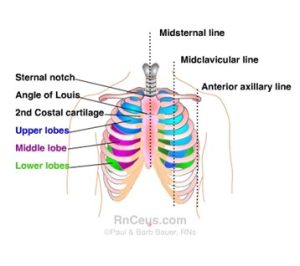Respiratory System
The respiratory system comprises organs and tissue working together to support breathing and maintain acid-base balance. The system is composed of an upper and a lower respiratory tract. The upper tract contains the nose and oropharynx. The lower respiratory tract includes the trachea, bronchi, bronchioles, alveoli, lungs, pleura, thoracic cage, and diaphragm. When performing a respiratory assessment, it is essential to identify specific landmarks to assist in referencing assessment findings in the appropriate anatomical context.

LEARNING OBJECTIVE
- Review the basic anatomy and physiology of the respiratory system.
- Complete a comprehensive assessment of the respiratory system.
- Understand the expected findings of a focused respiratory assessment.
- Review common pathological signs and symptoms of respiratory dysfunction.
- Learn appropriate documentation of assessment findings.
- Practice and apply critical thinking skills through applicable case study review.

